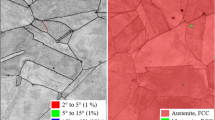Abstract
This investigation examines burnishing using a microscopic perspective and elucidates the mechanism of surface roughness improvement by asperity deformation. This study uses tribology theory to propose a burnishing factor L b to explain why the same burnishing result can be obtained in different burnishing conditions. The burnishing factor was determined by appropriate experiments, and the results demonstrated that a quadric curve relationship exists between surface roughness and burnishing factor and is analogous to the Stribeck curve in lubrication regimes.





Similar content being viewed by others
References
Morimoto T (1988) Work hardening and tool surface damage in burnishing. Wear 127:149–159
Fattouh M, El-Axir MH, Serage SM (1988) Investigations into the burnishing of external cylindrical surfaces of 70/30 Cu-Zn alloy. Wear 127:123–137
Klocke F, Liermann J (1998) Roller burnishing of hard turned surfaces. Int J Mach Tool Manufac 38:419–423
Hassan AM, Al-Bsharat AS (1996) Influence of burnishing process on surface roughness, hardness, and microstructure of some non-ferrous metals. Wear 199:1–8
Hassan AM (1997) The effects of ball- and roller-burnishing on the surface roughness and hardeness of some non-ferrous metals. J Mater Process Technol 72:385–391
Lee SSG, Tam SC, Loh NH (1993) Ball burnishing of 316 stainless steel. J Mater Process Technol 37:241–251
Loh NH, Tam SC, Miyazawa S (1993) Ball burnishing of tool steel. Precis Eng 15(2):100–105
Lee SSG, Tam SC, Loh NH (1992) A investigation into the ball burnishing of an AISI 1045 free-form surface. J Mater Process Technol 29:203–211
Loh NH, Tam SC (1989) A study of the effects of ball-burnishing parameters on surface roughness using factorial design. J Mech Work Technol 18:53–61
Loh NH, Tam SC, Miyazawa S (1993) Application of experimental design in ball burnishing. Int J Mach Tool Manufac 33:841–852
Yu X, Wang L (1999) Effect of various parameters on the surface roughness of an aluminium alloy burnishing with a spherical surfaced polycrystalline diamond tool. Int J Mach Tool Manuf 39:459–469
Hassan AM, Ai-Jalil HF, Ebied AA (1998) Burnishing force and number of ball passes for the optimum surface finish of brass components. J Mater Process Technol 83:176–179
Loh NH, Tam SC (1988) Effects of ball burning parameters on surface finish: a literature survey and discussion. Precis Eng 10(4):215–220
Zum Gahr K-H (1987) Microstructure and wear of materials. Elsevier, Amsterdam, pp 80–82
Czichos H (1978) Tribology, a system approach to the science and technology of friction, lubrication and wear. Elsevier, Amsterdam, pp 130–132
Hamrock BJ, Dowson D (1977) Isothermal elastohydrodynamic lubrication of point contacts, Part III: fully flooded results. J Lubrication Technol 264–276
Author information
Authors and Affiliations
Corresponding author
Rights and permissions
About this article
Cite this article
Lin, Y.C., Wang, S.W. & Lai, HY. The relationship between surface roughness and burnishing factor in the burnishing process. Int J Adv Manuf Technol 23, 666–671 (2004). https://doi.org/10.1007/s00170-002-1486-9
Received:
Accepted:
Published:
Issue Date:
DOI: https://doi.org/10.1007/s00170-002-1486-9




